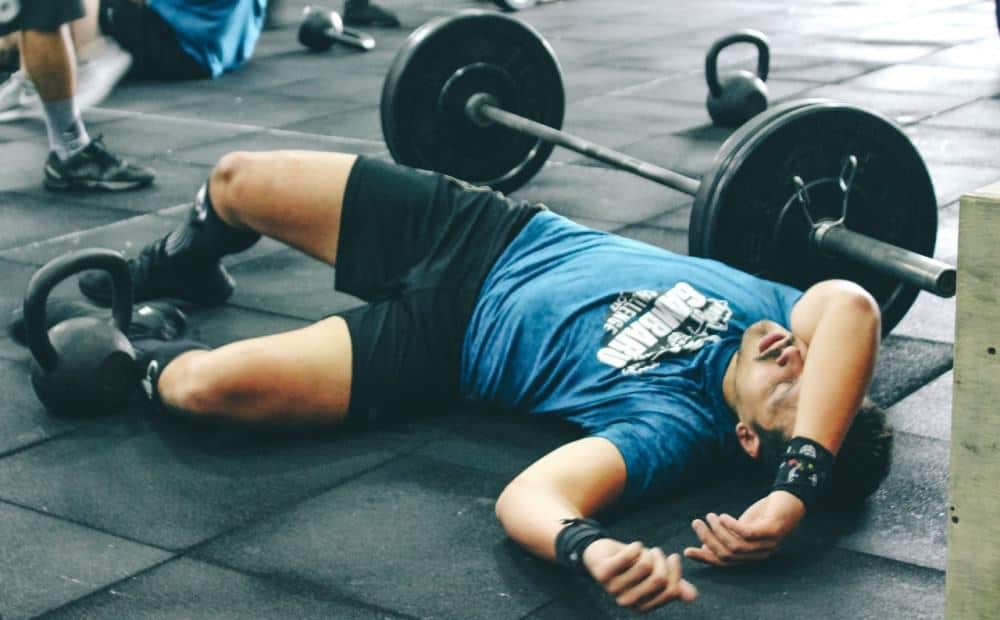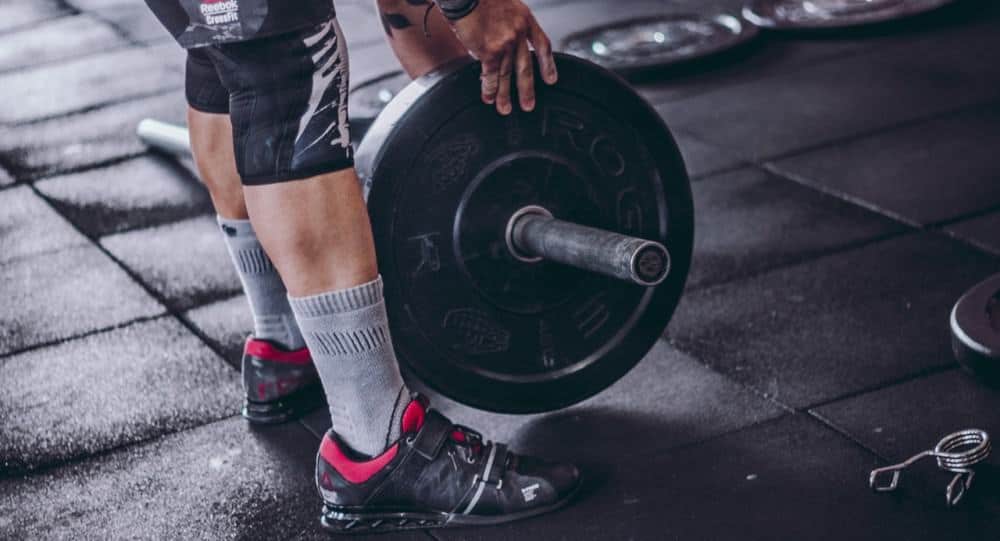Doggcrap? What a name for a training system. Quite funny, isn’t it?
It already implies what to expect from this program.
Particularly all among yourselves who have ever trained according to DC knows that there is nothing to laugh about.
You know what I’m talking about. It hurts. It’s tough. It’s exhausting.
But at the end of the day, there is no way around consistent, hard training if your goal is to achieve the body of your dreams.
So, what does doggcrapp actually stand for?
Doggcrapp is the forum nickname of its American inventor Dante Trudel.
When Dante launched his self-developed training system several years ago, no one expected it to be such a hit all over the world.
Had Dante foreseen his success, he probably would have chosen a better name for his training system.
His original intention was the constitution of a single Internet post, soon its pithy nickname Doggcrapp aroused great interest in fitness lovers and bodybuilders.
As a result, all threads about Doggcrapp rose at a rapid pace. The outcomes reveal a comprehensive discussion of his training principle, which has become widely known as DC Training today and is still used by many bodybuilders.
This is how the Doggcrapp training system was born.
Now, after we’ve covered where the suspicious name originates from, let’s discover how it’s actually assembled.
Basically, Doggcrapp training is a highly intensive training system. Only one set is performed for each exercise, but trust me, this set can be a hellish torment.
Therefore, it’s to no surprise designated for advanced athletes and bodybuilders who know their body and exercises well.

Why is it called Doggcrapp?
Quite simply: Doggcrapp or as it is written in English DogCrap or Dogs Crap, translates into dog shit or dog dung.
The name was thought as a joke from Dante Trudel who never expected his post to become as famous as it eventually became.
If you read his articles or descriptions, you should quickly realize that he clearly did not fall on his lips, but has an absolute gym slang and likes to exaggerate.
In other words, just a good sense of humor.
What is Doggcrapp?
Doggcrapp is an extreme form of high-intensity training.
The basic principles at one glance:
- Progressive weight increase
- Low training volume but high frequency
- Multiple rest-period training
- Extreme stretching
- No more carbohydrates at the end of the day
- Morning cardio
- High protein intake
- Loading and rest phases
It is a training system especially tailored for powerlifters and weightlifters, but also bodybuilders who want to build up muscle mass and strength simultaneously.
As already shortly mentioned, this training system is mainly intended for advanced athletes who want to set a new stimulus. It’s just that experienced athletes know what their bodies can endure and what not.
Since Doggcrapp can quickly cause overreaching, advanced athletes tend to have a better feeling for that and can counteract accordingly.
As with the systems of HIT or PITT Force, the Doggcrapp relies on the force equal to mass rule. This emphasizes the interplay between strength and muscle size.
For example, whoever benches 150kg is most likely to have a big chest, too. So, overall there is a great correlation between muscle mass and strength.
To take it even further, if you look at the whole professional bodybuilders, you can actually recognise this pattern.
On average, the more muscular athletes are also the stronger ones. For example, Ronnie Coleman or Arnold Schwarzenegger back in the 70s. Both of them were known for their incredible physique and ridiculous power.
Quite logical, isn’t it?
Think of it this way. The process of building muscles is actually just the recovery of many microtraumas caused by heavy and consistent training. In turn, our body repairs all damaged cells and eventually, improved strength prompts our muscles to adapt to the increased load and grow correspondingly.
As you can see, there is a correlation between muscle size and strength, at least to a certain degree.
It’s not about the sheer pump, the stimulus to grow our muscles counts.
A pump is simply an accumulation of blood which does not represent a muscle-building stimulus.
For this reason, a pump does not play a major role in Doggcrapp training.

Exercise technique
A proper exercise performance, however, occupies a key position. The weights always have to be carried in a controlled manner, all the way up and down.
Since the negative phase or so-called eccentric phase is the most demanding, it is important to maintain a deliberately slow and controlled execution.
Having said that, the goal is to literally exert as much “damage” as possible. That is to cause lots of little microtraumas which form the basis and requirement of muscle growth.
Microtraumas can be described as minor muscle injuries, which grow into stronger muscles with sufficient regeneration and nutrients.
Intensity
Each set lasts until you’re not capable to perform another rep out of your own power. However, since the muscle has not yet been fully stimulated and still has reserves, the systems cotinues with a “follow up set”.
The Doggcrapp training system provides the following intensity levels in order to go to the absolute limit. Sorted ascending according to intensity (1 = easy, 4 = the absolute end).
- Rep maximum + extreme stretching
- Rep maximum + extreme stretching + static hold for 20-30 seconds
- Rep maximum + rest breaks + extreme stretching
- Rep maximum + rest breaks + extreme stretching + static hold for 20-30 seconds
Since it is always the goal to aim for maximum intensity and growth stimulus, the various exercises can be performed even more intensively depending on its angle and setting.
For example, special emphasis on a particular movement phase, additional reps, static holding, short breaks, etc.
Warm-Up
Just like High-Intensity training, Doggcrapp is extremely demanding and the susceptibility respectively high.
Therefore, it is important to emphasize on a thorough warm-up before you start. It’s best to start with a general warm-up of 10-15 minutes at a moderate pace on either bike, cross-trainer or treadmill.
In addition, you should gradually increase the weight per exercise and muscle group before you start with your first “working set”.
For example, if you have a set of 100kg bench press, start with 20x 20kg, followed by 15x 40kg, 12x 60kg, 8x80kg and then, at last, your maximum set.
Nevertheless, this is only an example. If you feel warm after the first two warm-up sets, you’re welcome to start.
Most importantly to mention, never go to failure in your warm-up sets. This is only mandatory in your last set.
As a rule of thumb, the heavier the weight the more warm-up you have to do. Most of the times 1-5 warm-ups are normal and required.
Variation
As already addressed earlier, strength interplays and correlates with muscle size. Exactly this concept is consistently enforced in Doggcrapp training.
This means that you either need to try to increase weight or reps in each session. Whatever choice you make, it doesn’t matter. Both approaches result in progression.
Consistent progression overtime is the key to muscle growth.
However, increasing weight is probably the most common and convenient way. If you rather like to increase the performed reps, then feel free to do so, if not, then don’t.
Since progression is not always possible, otherwise we all would bench 200kg, the second special feature of Doggcrapp is used.
As you may have guessed, it’s variation. If you’re not able to improve your performance in one exercise, replace it with another, equivalent exercise.
Anyhow, that should not be the problem anymore, because Doggcrapp provides only one exercise and one maximum set per muscle group.
In order to create the greatest stimulus, variation not only applies to the selection of exercises but also to training as a whole. Changing your workouts will further increase variety.
Doggcrapp splits training into two parts:
- Muscle groups 1: chest, shoulder, triceps, back width, back depth
- Muscle groups 2: biceps, forearms, calves, quads, hamstrings
Trudel recommends this combination because the largest muscle groups (back and thighs) and thus heaviest loads are trained separately.
Back training is specifically split into width and depth.

Doggcrapp sample training plan
- Monday: Chest, shoulder, triceps, back width, back depth
- Tuesday: Rest
- Wednesday: Biceps, forearms, calves, quads, hamstrings
- Thursday: Rest
- Friday: Chest, shoulder, triceps, back width
- Saturday: Rest
- Sunday: Rest
As you can see, the muscle groups remain being split up the same, only the composition changes. The exercises from the first plan are simply changed in the second plan.
For example, if you did bench press in Plan 1, you’ll do Incline bench press in Plan 2. In other words, the exercises change but the rest stays the same.
Doggcrapp advantages
Advantages of Doggcrapp training at one glance:
- Every muscle is trained exactly 3 times in 14 days
- Different exercises for each muscle group per workout (3 exercises for each muscle)
- 3x growth stimuli in 2 weeks (a conventional 3-split has only 2 growth phases in 2 weeks.
Doggcrapp has 78 growth phases per year whereas 3-split amounts up to 52 growth phases per year.
Since it not possible to make many sets with maximum intensity when using a conventional loading scheme, the volume is accordingly low.
Eventually, this allows a higher frequency. The central nervous system is less stressed but our muscles, even more, which is the ultimate purpose.
Repetition range
This depends largely on the exercise and muscle group but on average the rep range is in between 11-15 reps, including rest breaks.
For example, take bench press: Imagine you’re doing 8 reps, then put the weight in the tray, take 15 deep breaths and do another 3 reps, put the weight back in the tray again, take another 15 breaths and squeeze out 2 more reps. This will give you a total of 13 reps.
Rest break sets
What is a rest break set actually?
Well, these are sets after reaching the repetition maximum in the actual work set.
They serve to increase the load and intensity on our muscles.
Since the repetition maximum is not yet a full muscle failure, it’s just a short interruption.
Put the weight back in the tray, take some breaths and then try to perform as many reps as possible with the same weight.
The set should be terminated when after 15 deep breaths you’re still not able to do a single more rep. Alternatively, you can use the above-mentioned intensity techniques to push even further.
But be aware, Dante Trudel does not recommend applying rest break sets for each exercise.
For example, when cruising, barbell or T-dumbbell rowing or squats. Due to the heavy weight and high intensity, the body quickly gets tired and proper technique can subside, which increases the risk of injury.
Extreme stretching
Extreme stretching has the following advantages if applied correctly:
- Improved recovery
- Increased muscle fascia size
- Potential hyperplasia (muscle cell division)
After you’ve finished one particular muscle group, it’s time to implement extreme stretching.
Each stretch should be held for 60-90 seconds, including static contraction and or static reps.
What does static contraction mean?
Basically, a static contraction refers to holding the weight at the point of greatest stress.
If you’re looking for an extreme intensity boost, here you go. But be cautious, the pain will reach its peak. It’s just brutal, trust me.
Static contraction or static repetitions should be done after rest break sets and before extreme stretching. This will literally lambast you.
What are static repetitions?
To put it simply, they are very short reps at the point of greatest tension.
The weight is held and minimally moved up or down by about 2 centimeters.
Both variants of the static tension are suitable, whichever you chose is up to you. There is no right or wrong. Try them both and find out which one suits you the best.
Doggcrapp innovations
Due to the basic principles described, muscles are not capable of adapting so quickly and yet gets more recovery through the different exercises. Therefore, you should be able to continuously increase your weight.
If your body sustains the current intensity well, it is possible to expand and divide training into 3-split.
Doggcrapp then provides the following division:
- Muscle groups 1: chest, shoulder, triceps
- Muscle groups 2: back width, back depth, biceps, forearms
- Muscle groups 3: calves, quads, hamstrings
Training schedule:
- Monday: Training schedule 1 (chest, shoulder triceps)
- Tuesday: Training schedule 1 (back width, back depth, biceps, forearms)
- Wednesday: break
- Thursday: Exercise Plan 1 (calves, quads, and hamstrings)
- Friday: Training schedule 2 (chest, shoulder, triceps)
- Saturday: break
- Sunday: break
- Monday: Training schedule 2 (back width, back, biceps, forearms)
- Tuesday: Training schedule 2 (calves, quads, hamstrings
- Wednesday: break
- Thursday: Training schedule 1 (chest, shoulder, triceps)
Dante Trudel strongly recommends doing cardio.
I know guys.. I am not the biggest fan of cardio either:D
But anyhow, cardio has a lot of benefits which is why you should definitely consider it.
On the one hand, it can prevent us from getting too bulky, stimulate our appetite, improve recovery and rev up the cardiovascular system.
However, cardio is not a duty and can be considered as an addition.
If you decide to do cardio, then I would suggest to either do it outside, on a treadmill, stepper or bike.
Make sure to keep it moderate and not too intense. Preferably on rest days in the early morning. This burns even more fat and stimulates the appetite throughout the day.
But wait, what about “cardio hampers muscle growth”?
Bullshit. Literally nonsense, guys. Honestly, this is one of the most persistent myths and is a bunch of crap, as Trudel says.
Whether you gain weight still depends mainly on your calorie record throughout the entire week.
You won’t get fat when cheating once. You won’t get skinny when dieting one day either.
It’s about consistency.
Note that and keep it in your mind. Both training and nutrition need to be properly aligned and paid attention to consistently.
Which exercises suit Doggcrapp particularly well?
First and foremost, of course, basic exercises. Basic exercises are always great, to develop body tension, strength and overall increase muscle size.
Particularly exercises that involve several muscle groups at the same time, such as bench press, deadlifts, squats, shoulder press, dips, and rowing movements.
These are all great exercises to chose from.
In the beginning, select 3 exercises per muscle group. You could choose your favorite exercises. These are usually your strongest and with whom you have had good experiences so far.
These conditions are optimal and a prerequisite for accelerating muscle growth even further.
With regard to all selected exercises, the idea is to rotate them each training session. Due to that, you won’t reach a plateau near-term.
In addition, the selected exercises should allow for greater weight gain in the long run. This means that isolation exercises, for example, kickbacks are less well suited than a tight grip bench press.
I think you get the point. Stay with basic exercises.
On the one hand, these involve several muscle groups simultaneously and on the other hand, you can use really heavy forces.
Therefore, the strong muscle mass interplay is ensured whereupon the whole training system is based.
Once you’ve selected the exercises, make sure to rotate them every now and then. This prevents stagnation and ensures proper muscle growth.
Importantly, exercise is only replaced when you can’t improve anymore. This way progress is imposed, otherwise, you’ll lose your favorite exercise if you stagnate 😉
Tracking progress
Mandatory! That’s what Dante Trudel would say to you.
Whether you write down which weights you moved during training by hand, use an online spreadsheet or take notes on your smartphone doesn’t matter at the end.
All result, or at least should, in the same outcomes. A clear overview of your progress during the last months.
Particularly, in the long run, it’s almost impossible to remember all weights used, but for continuous progress, it’s essential to have an overview.
Along these lines, I highly recommend tracking your weights either directly during the workout in a small notebook or your phone or immediately after coming home.
Sooner or later you’ll be in such a situation where you’re uncertain whether having benched 100kg or 110kg for 7 or 8 reps. And that exactly contributes to the assessment whether progress is made or not.
How long is the optimal Doggcrapp period?
Now after all the theory is covered, the question arises for the optimal usage length of Doggcrapp.
In most cases, it depends on your condition and training level.
As I mentioned above, this training system is mainly suited for experienced athletes.
To give you a rule of thumb, it’s over when nothing works anymore. In particular, that is when stagnation shows up.
This may be the case for some people after 4 weeks whereas other folks can sustain Doggcrapp for a whole duration of 20 weeks.
Factors such as your regeneration capability and muscle growth exert significant influence. In order to reach the best possible progress, it is necessary to optimize all variables such as enough sleep (also sleep quality), nutrition (!), technique and execution of all exercises and also proper hydration.
All these factors need to be perfectly aligned day in and day out.
Since there is no endless progression, you are simply forced to stop at some point.
However, it is generally recommended to limit the use of Doggcrapp to 6-10 weeks followed by a break of 7-10 days.
Anyhow, if you’re still feeling fresh after 10 weeks and manage to increase your weights without issues, with consistently good execution technique, then you should take advantage of this momentum and carry on.
But if it’s just going on sluggishly, terminate the whole program and start over again.
Loading and rest phases
The loading phase should take about 6-8 weeks, as Dante recommends himself. Afterward, a rest phase of 10-14 days follows.
During the rest phase on meal per day is skipped and only one maintenance (MV) training is carried out.
Its main purpose is to enable your body and muscles full recovery before the next training system starts.
Therefore, during these 10-14 days, it intends only 2-3 light, maintenance training sessions.
With this in mind, the actual workout should be easy and conducted with a full range of motion.
Especially during rest phases, it’s a great time to check out new exercises and get used to them.
Prop up your legs and watch your muscle grow. You deserve it.
Doggcrapp nutrition
That sounds weird, doesn’t it?
Don’t you always tell us to keep a healthy and balanced diet? Now you want us to eat like doggcrapp?
Good catch, folks. I certainly did and probably always will.
There is no way around proper nutrition.
Dante Trudel specifically emphasizes how important nutrition is in order to succeed in his program.
Honestly, I can’t tell you flat rate whether you need to follow the recommendations below strictly, but however, I’ll list them for you.
- At least 2g protein per kg of body weight. For example: 70kg athlete = 140g protein
- Drink a lot. As a guideline, I always recommend drinking 1L per 20kg of body weight. For example, 70kg athlete = 3.5L per day
- No carbohydrates after 6 pm (exception post-workout meal)
- Only eat fat and protein or protein and carbohydrates together
- In meals which include carbohydrates and protein, the protein should always be eaten first, then the vegetables and finally the carbohydrates
- Athletes who tend to put on weight faster and are sensitive to carbohydrates should eat more protein and fat and consume carbohydrates only pre and post-workout.
- If you want to look like a 100kg athlete, you also have to eat like on? says Dante Trudel
- Use key supplements such as protein powder, green tea, etc.
Well, frankly I am not a supporter of all these recommendations, but I assume Mr. Trudel put some thought into them.
In fact, high protein consumption, drinking sufficient water and eating in accordance to your ultimate goal is nothing new, but aspects like no carbohydrates after 6 pm make me start to wonder.
Therefore, treat those recommendations with caution, give them a try but keep in mind that it may be different for your individual conditions.
Final thoughts
As mentioned in the introduction, DoggCrapp is only for people who have been training hard for years and know how to overcome their limitations.
You certainly have to know your body well to succeed with High-Intensity training systems.
I would recommend taking one of your gym buddies instead of going alone into the battle.
But however, if you decide to try DoggCrapp, I wish you much success and good gains!
Did you ever hear about DoggCrapp yet? What did appeal you the most? Would you consider trying it out?
Engage in the comments below and share your experiences with us!
Also, make sure to subscribe and follow our social media channels.
Get fit, healthy and successful.
Cheers for reading,
Claas




